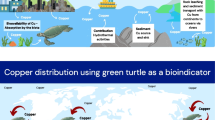Abstract
Wet and dry weight, total carbon, nitrogen, hydrogen, and ash contents were determined on 33 species of zooplankton distributed predominantly in the open sea region of the North Pacific. Sampling covered the waters from 44°N to the equator. Average percentage of dry weight to wet weight was about 19% of all samples from the whole area. Percentage dry weight of carbon in copepods was on an average 51.5%. The highest value, 66.6%, was obtained in eggs of the copepod Pareuchaeta sarsi. Mixed zooplankton was assumed to contain carbon comprising about 35 to 45% of the dry weight. Carbon contained in the zooplankton biomass existing in the upper 200 m in the western parts of the northern North Pacific and Bering Sea during spring and summer was estimated to range from 20 to 85 mg C/m3. Nitrogen content varied considerably with localities. Average ratio of carbon to nitrogen was 8.5 in subarctic copepods, and 4.1 in subtropic-tropic copepods. This ratio also varied with season. In the copepod Calanus cristatus the ratio was highest (10.0) in May, immediately after the spring bloom of phytoplankton, when the animals contained much fat. The ratio fell to 5.1 in December. There seemed to be a large seasonal variation in boreal zooplankton due to great fluctuations of environmental conditions, especially the amount of food available; in tropical species the range was small because of environmental uniformity. Average hydrogen content was about 6 to 10%. The percentage of ash to dry weight amounted to 39.3% in pteropods and 3.4% in copepods.
Similar content being viewed by others
Literature cited
Beers, J. R.: Studies on the chemical composition of the major zooplankton groups in the Sargasso Sea off Bermuda. Limnol. Oceanogr. 11, 520–528 (1966).
Bogorov, V. G.: Unification of plankton research. Année biol. 33, 299–315 (1957).
— and M. E. Vinogradov: Some essential features of zooplankton distribution in the northwestern Pacific Ocean. [Russ.] Trudy Inst. Okeanol. 18, 113–123 (1955).
—: The distribution of zooplankton in the Kurile-Kamchatka region of the Pacific Ocean. [Russ.] Trudy Inst. Okeanol. 34, 60–84 (1960)
Brandt, D. und E. Raben: Zur Kenntnis der chemischen Zusammensetzung des Planktons und einiger Bodenorganismen. Wiss. Meeresunters. (Abt. Kiel). 19, 175–210 (1919–1922).
Conover, R. J. and E. D. S. Corner: Respiration and nitrogen excretion by some marine zooplankton in relation to their life cycles. J. mar. biol. Ass. U.K. 48, 49–75 (1968).
Curl, H., Jr.: Analyses of carbon in marine plankton. J. mar. Res. 20, 181–188 (1962a).
—: Standing crops of carbon, nitrogen, and phosphorus and transfer between trophic levels in continental shelf waters south of New York. Rapp. P.-v. Réun. Cons. perm. int. Explor. Mer 153, 183–189 (1962b).
Cushing, D. H., G. F. Humphrey, K. Banse and T. Laevastu: Report of the committee on terms and equivalents. Rapp. P.-v. Réun. Cons. perm. int. Explor. Mer 144, 15–16 (1958).
Harris, E. and G. A. Riley: Oceanography of Long Island Sound, 1952–1954. 8. Chemical composition of the plankton. Bull. Bingham oceanogr. Coll. 15, 315–323 (1956).
Hensen, V. von: Über die Bestimmung des Planktons oder des im Meer treibenden Materials an Pflanzen und Tieren. Ber. Commn wiss. Unters. dt. Meere Kiel 5, 1–108 (1887).
Hozumi, K.: An instrumental method for the simultaneous microdetermination of carbon, hydrogen, and nitrogen. Microchem. J. 10, 46–60 (1966).
Krey, J.: Chemical determination of net plankton, with specieal reference to equivalent albumin content. J. mar. Res. 17, 312–324 (1958).
Marshall, S. M., A. G. Nicholls and A. P. Orr: On the biology of Calanus finmarchicus. 5. Seasonal distribution, size, weight and chemical composition in Loch Striven in 1933 and their relation to the phytoplankton. J. mar. biol. Ass. U.K. 19, 793–828 (1934).
Nakai, Z.: The chemical composition, volume, weight, and size of the important marine plankton. [Jap.] J. oceanogr. Soc. Japan 1, 45–55 (1942). [English translation: Tokai reg. Fish. Res. Lab. Spec. Publ. 5, 12–24 (1955)].
Omori, M.: A 160 cm opening-closing plankton net. 1. Description of the gear. J. oceanogr. Soc. Japan 21, 212–220 (1965).
Omori, M.: Variations of length, weight, respiratory rate, and chemical composition of Calanus cristatus in relation to its food and feeding. Ms. Symposium on Marine Food Chains. No. 10. Aarhus: 1969 (in press).
Vinogradov, A. P.: The elementary chemical composition of marine organisms. Mem. Sears Fdn mar. Res. 2, 1–647 (1953).
Vinogradov, M. E.: The distribution of zooplankton in the western areas of the Bering Sea. [Russ.] Trudy vses. gidrobiol. Obshch. 7, 173–203 (1956).
Author information
Authors and Affiliations
Additional information
Communicated by M. Anraku, Nagasaki
Rights and permissions
About this article
Cite this article
Omori, M. Weight and chemical composition of some important oceanic zooplankton in the North Pacific Ocean. Marine Biology 3, 4–10 (1969). https://doi.org/10.1007/BF00355587
Accepted:
Issue Date:
DOI: https://doi.org/10.1007/BF00355587




